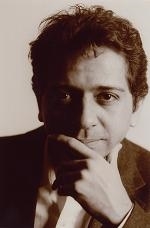 |
| Ariel Ruiz i Altaba ©Ariel Ruiz i Altaba, all rights reserved. |
Ariel Ruiz i Altaba creates stunning photographs that live at the intersection of biology and art. His images provoke an array of emotions while raising issues of identity. He also happens to be a scientist studying brain development and cancer. The opening statement on his lab website in Geneva reads, "The overall aim of our research is to understand how form develops in the embryo, how it is maintained in the adult and how it is deregulated in diseases." Ariel holds a doctorate in molecular biology and biochemistry from Harvard University in Cambridge, and did post-doctorate work at the College of Physicians and Surgeons of Columbia University, as well as a stint as associate professor at the Skirball Institute at the New York University School of Medicine. Dr. Ruiz i Altaba floats easily between the worlds of art and science. It is probably why he founded WetLab, an innovative forum based in New York City that hosts a meeting of the minds among a community of visual artists, scientists and writers. "WetLab focuses on the exploration of how biological science is shaping our environment, society and identity, highlighting aesthetic and ethical perspectives."
Born in Mexico City, Ariel grew up in Barcelona and Catalonia, Spain before going to New York for his college and early working years. He now lives in Geneva, Switzerland and is Jeantet Professor at the University of Geneva Medical School where he is still exploring both science and art. It's where MY HERO caught up with him for this interview.
Which came first for you, science or photography?
"Photography, from the age of ten, more or less. Images have always been captivating for me." His mother, a painter, exposed him to art at an early age and since then he has been inspired by fellow artists, especially in New York. He told me, "As for science, well there is a long path. From my first interests in the natural world in early childhood (animals, shells, etc.) to moving to New York from Barcelona and attending classes at NYU, to finishing college because I wanted to study molecular biology, to Columbia University, to Harvard and on and on. This is an exacting and exciting career."
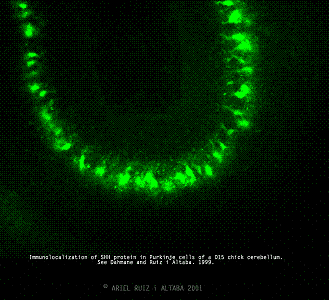 |
| Immunolocalization of SHH protein in Purkinje cells of a D15 chick cerebellum. (See Dahmane and Ruiz i Altaba, 1999) © Ariel Ruiz I Altaba, all rights reserved. |
How does one help the other?
"For me they are complementary and balance my psyche, my motivations and interests. During graduate school I pretty much left art on the back burner and I did suffer from this decision. Afterward, during my post-doc, I began to feel the need to be active in the art field again and decided soon after to start production at a professional level, being fully involved in the art world." Ariel's artwork has been featured in magazines, art galleries and museums around the world.
Does your eye for intersecting art with science help your intuitive process while doing your research?
"Absolutely, and the other way around too. More than once I have had some scientific epiphanies while scrutinizing the work of Rembrandt, Vermeer, Bosch, Tapies, Serra, Botticelli, Miro, Caravaggio or Rothko for instance. And very often, scientific data and experimental results provide the initial spark for artistic creation. I try to see with new eyes."
There are two major lines of research in Ariel's laboratory that focus on the role of the Gli proteins in development and in disease.
1. Normal Development: "We are focusing on the role of Gli proteins in different but related aspects of animal development."
2. Disease: "Our research on the pattern formation of early embryos has taken us to study two types of diseases. i-diseases due to cell loss, such as Parkinson's disease, and ii-diseases due to non-homeostatic increase in cell number, such as cancer."
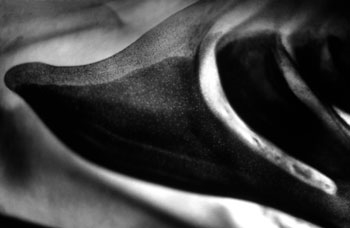 |
| 73. Embryonic Landscapes Series. ©Ariel Ruiz i Altaba, all rights reserved. |
I asked Ariel to explain in simple terms, what his research is about and what he is looking to find.
"Form is a basic element of the visual world. How does it come about? Why does a hand have 5 fingers? How do legs appear? These first develop in the embryo, so to understand this question and many others like this one, one has to understand the very early stages of animal development. For instance, how does the brain develop its form? How does it grow during an initial period and then pretty much stays the same? These questions can also be applied to single tissues and cell types, like different kinds of neurons or muscle cells. My interest lies in the generation of form and how we perceive it. In art this leads to questioning form and the concept of landscape for instance. In science, this leads to trying to understand the genes and cellular processes that organize cells into organs and organs into individuals. In particular, we are trying to figure out how stem cells maintain and create tissues and how these processes go wrong in cancer, as this can be seen as a disease of too many disorganized cells."
I asked Ariel if our health is predetermined by the information encoded in our DNA.
"Not completely, but certain gene variants and mutations can predispose us towards different outcomes. Nevertheless, not all persons with genes carrying these or other mutations or changes develop the disease. Very few diseases are purely dependent on single genes and single changes in these genes. The rule is that diseases have very complex genetic influences."
And what about the mind/body connection? Does he believe that "mind over matter" can play an important, possibly miraculous role in curing oneself of ailments?
"The placebo effect is well documented. This points to a powerful effect of the will and a certain mental state on the way our bodies react to disease. Aspects of Buddhism and a connection with a larger self in the natural world also have a lot to teach us. There is a lot to discover in these areas."
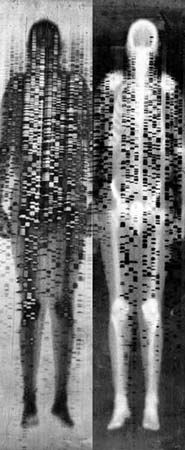 |
| Twins. Genome and Identity Series. ©Ariel Ruiz i Altaba, all rights reserved. |
One of the many articles Dr. Ariel Ruiz i Altaba has had published is titled, "Stem cells, regenerative medicine and a cure for cancer?" With cancer rates seemingly on a steady rise, these are very hot topics in science these days. I asked him to explain the general idea of his piece.
"It describes the great potential of stem cell research and its implications for regenerative medicine to cure cell degeneration and loss. But also to cure diseases that are caused by too many cells without proper pattern: cancer. We have been working for nearly a decade on cellular processes that are misregulated in a very large number of human cancers. We have found, for instance, that human cancers require the sustained activity of the 'Hedgehog-Gli' pathway (the names refer to the specific genes) and with this the hope of a wide-spectrum anti-cancer therapy for many human cancers that remain incurable today. Our research has taken us from looking at bacteria, viruses and early frog and chick embryos to the analyses of metastatic human tumors. It has been a wonderful ride, full of bumps, ups and downs."
I wondered what advice this fascinating man, both scientist and artist would have for kids wanting to become scientists one day.
"Be confident of your questions but do not think you have all the answers. Be happy that you have partial answers, but do not think they are the final ones. A good answer always brings a new question. Living with uncertainty is liberating. Avoid verbosity and pedantry. Ask a question only after you have done your own research on the matter. Think hard, always, and don't be afraid to ask about what you do not know. No one knows everything. Trust yourself in the face of loss or ridicule, and smile. Leave your personal feelings at the door. And be happy to be proven wrong as this is the proof that you have really learnt something new."
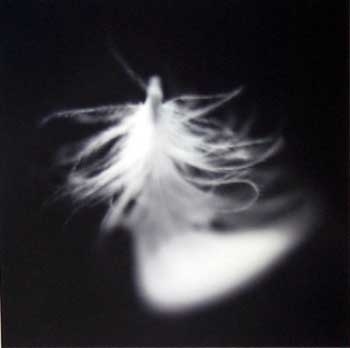 |
| Dancing in the Wind. Biophilia Series. ©Ariel Ruiz i Altaba, all rights reserved. |
What makes this complex man laugh?
"Something unexpected, a connection that is unusual. I guess, like everyone else, well, something funny."
What do you do for fun?
"What I do and love is fun! This question is, sadly enough, for those who do not do what they want to do."
Who is your hero and why?
"Ah, heroes. I do not believe in heroes. I believe in normal people. But what examples have guided me? Well, Darwin, Miro?"
I spent many hours clicking through Ariel's photographs on his website. His images moved me deeply and I kept trying to explain them to myself. Kept trying to define them absolutely. I asked Ariel many questions about his images. He told me, "For a variety of reasons, I prefer to leave the images as they are. They ask more than they answer. They are open doors, not documents, scriptures or formulae. They are emotional gates, not hard facts. They are personal interpretations, not representations. They are different things to different people. They require a personal involvement and a certain time of introspection."
Trust me. When you have some time, go to his website, Ariel Ruiz i Altaba Studio, and treat yourself to your own personal art adventure. You'll be glad you did.
Page created on 3/24/2006 11:25:46 AM
Last edited 1/9/2017 9:32:56 PM
